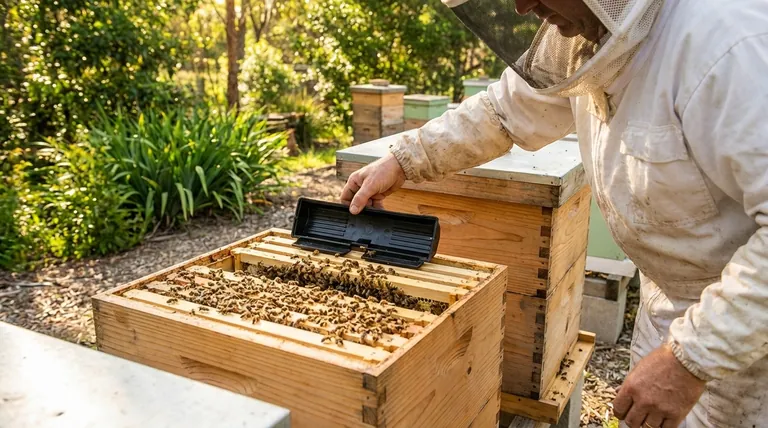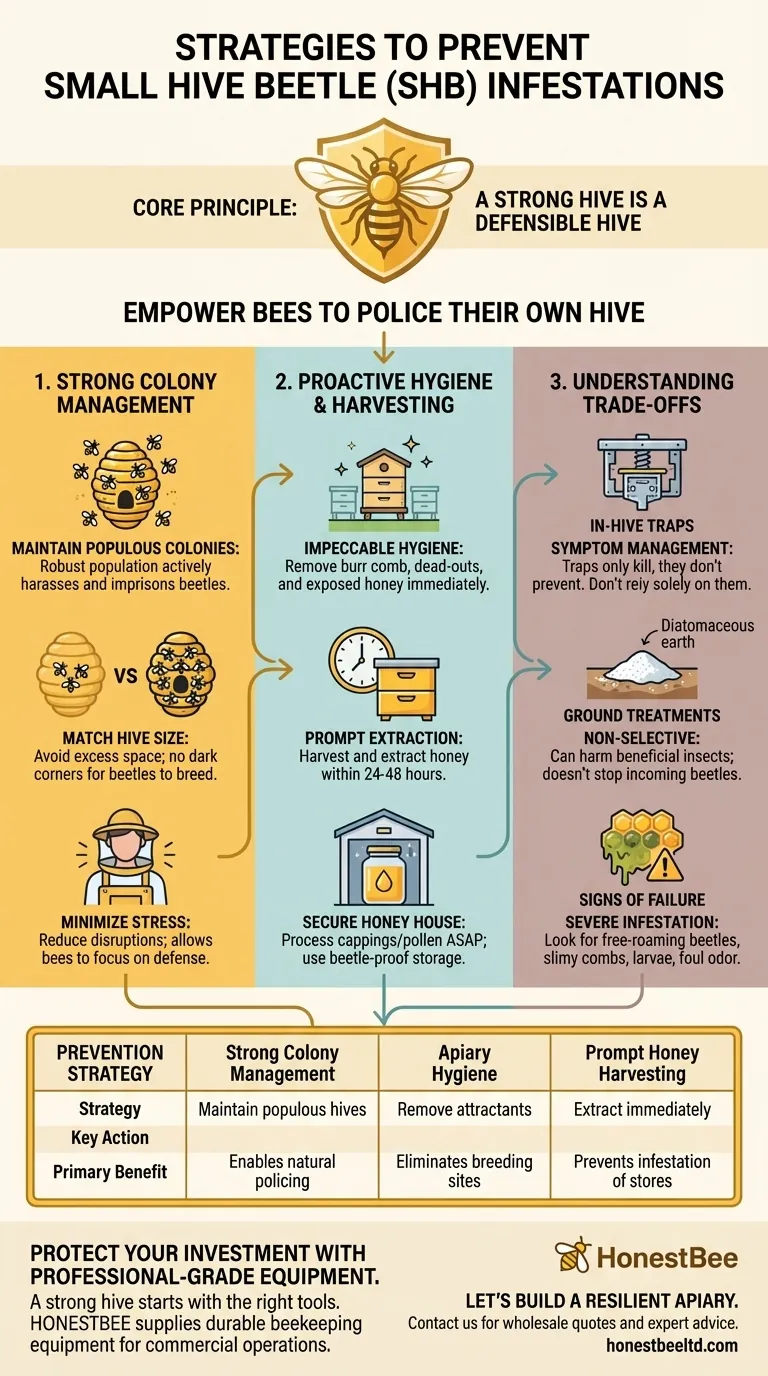To effectively prevent small hive beetle (SHB) infestations, your strategy must focus on two primary areas: maintaining exceptionally strong, populous bee colonies and practicing meticulous apiary and honey house hygiene. These foundational principles create an environment where the bees themselves can effectively police their hive, preventing beetles from gaining the foothold they need to reproduce and cause damage.
The central takeaway is that small hive beetle management is not about killing every beetle but about empowering your bees to defend their own space. A strong, healthy, and appropriately-sized colony is the single most effective defense against a SHB takeover.

The Core Principle: A Strong Hive is a Defensible Hive
The foundation of SHB prevention is recognizing that your bees are the primary defense force. Your job is to support their ability to do this work.
Why Colony Strength Matters
A hive teeming with worker bees has a robust defensive population. These bees will actively harass, capture, and imprison small hive beetles in "jails" made of propolis, effectively neutralizing them.
Weak or struggling colonies lack the population density to adequately patrol the hive. This allows beetles to move, feed, and lay eggs unchecked.
The Danger of Excess Space
Small hive beetles thrive in dark, empty corners of the hive where bees are not present. Every frame of comb should be well-covered by bees.
If you have a weak colony in a large hive body (e.g., a small nucleus colony in a 10-frame deep), you are providing a perfect breeding ground for SHB. It is critical to match the size of the hive to the size of the bee population.
Minimizing Hive Stress
Every time you open a hive, you disrupt the colony's internal environment and social structure. Frequent or lengthy inspections can stress the colony, diverting resources from defensive tasks like beetle management.
Work efficiently and purposefully when you must inspect, and avoid disturbing the bees unnecessarily, especially during periods of high SHB pressure.
Proactive Apiary and Honey House Management
Your actions outside the hive are just as critical as what happens inside. Beetles are opportunistic and will exploit any available food source.
Practice Impeccable Hygiene
Do not leave burr comb, dead-outs, or discarded frames of honey or pollen exposed in your apiary. These materials are powerful attractants for SHB and other pests.
Keep the area around your hives clean and tidy to reduce potential hiding and pupating sites for beetles.
Prompt Honey Extraction
Once honey supers are capped and ready for harvest, remove them from the hive without delay. Honey-filled combs left in the hive for too long can become a target, especially in weaker colonies.
After removing supers, extract the honey immediately—ideally within 24-48 hours. Stored supers of honey are highly vulnerable to SHB infestation, as there are no bees to defend them.
Secure the Honey House
Your extraction area is a major point of vulnerability. Beetles can infest beeswax cappings and pollen left in open containers.
Process your wax cappings and any collected pollen as soon as possible after extraction. If you must store them, use sealed, beetle-proof containers.
Understanding the Trade-offs and Risks
While the core principles are straightforward, it's important to understand the limitations of certain tools and the signs of a failing defense.
The Limits of In-Hive Traps
Many beekeepers use mechanical traps filled with oil or diatomaceous earth inside the hive. While these can capture and kill a large number of beetles, they are a symptom management tool, not a preventative solution.
Relying solely on traps without addressing the underlying issue of colony weakness or excess space means you are fighting a losing battle. A strong hive should not need extensive trapping.
The Ground Treatment Dilemma
Some recommend using diatomaceous earth on the ground in front of the hive to kill beetle larvae seeking to pupate in the soil.
This can be moderately effective, but it is non-selective and can harm beneficial ground-dwelling insects. It also does nothing to stop adult beetles from flying into the hive from other sources.
Signs of a Lost Battle
You must know when prevention has failed. If you see a large number of beetles roaming freely, a slimy coating on the combs, or white beetle larvae crawling through cells, the infestation is severe.
The presence of a foul odor, often compared to decaying oranges, is a definitive sign that the beetle larvae have caused the honey to ferment and the hive is likely beyond saving.
Making the Right Choice for Your Apiary
Your specific actions should be tailored to your goals and the current state of your colonies.
- If your primary focus is routine prevention: Keep your colonies strong, ensure they are in correctly sized equipment, and maintain excellent apiary hygiene.
- If you are preparing to harvest honey: Remove honey supers the moment they are ready and extract them immediately to prevent post-harvest infestation.
- If you are managing a weaker colony: Reduce the hive to the smallest possible space the bees can fully occupy and defend, and consider reducing the entrance to limit access.
Ultimately, your role is to be a strategic partner to your bees, creating an environment where their powerful natural defenses can easily overcome any pest.
Summary Table:
| Prevention Strategy | Key Action | Primary Benefit |
|---|---|---|
| Strong Colony Management | Maintain populous hives in correctly sized equipment. | Enables bees to naturally police and imprison beetles. |
| Apiary Hygiene | Remove burr comb, dead-outs, and exposed honey/pollen. | Eliminates attractants and breeding sites for SHB. |
| Prompt Honey Harvesting | Remove and extract honey supers immediately after capping. | Prevents SHB from infesting undefended honey stores. |
Protect Your Investment with Professional-Grade Equipment
A strong hive starts with the right equipment. HONESTBEE supplies durable, well-designed beekeeping supplies and equipment to commercial apiaries and beekeeping equipment distributors through our wholesale-focused operations. The right tools help you maintain the strong, defensible colonies that are your best defense against small hive beetles.
Let's build a more resilient apiary together. Contact HONESTBEE today for a wholesale quote and expert advice.
Visual Guide

Related Products
- Black Plastic Beetle Barn Hive Beetle Trap for Beehives
- Reusable Clear Small Hive Beetle Traps for Beehives Beetle Trapping Tools
- Plastic Beetle Blaster Trap Beekeeping Tools and Supplies
- Wholesales Dadant Size Wooden Bee Hives for Beekeeping
- Removable Washable Hive Beetle Trap Attractants for Small Hive Beetles
People Also Ask
- What is the best time to use beetle traps? Master the Spring Strategy for Effective Hive Protection
- What are the steps for installing hive beetle traps? A Guide to Effective Beetle Control
- How should filled beetle traps be handled? Safely Remove and Dispose to Protect Your Hive
- Why are hive beetle traps important for beekeepers? Protect Your Hive from a Devastating Infestation
- What tips can help prevent hive beetle infestations? Build Strong Colonies & Master Apiary Hygiene



















